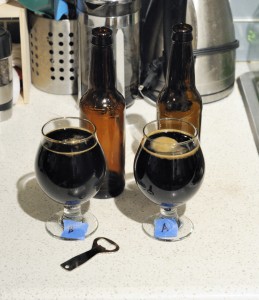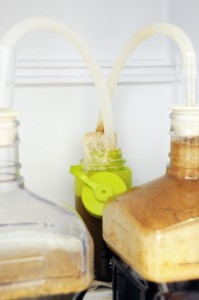Over a year ago, I took a shot at brewing a clone of Firestone Walker’s Parabola. According to Firestone Walker, Parabola is characterized by:
Bold bourbon, tobacco and espresso aromas and a hint of American oak greet the nose. Rich, chewy roasted malts, charred oak and bourbon-like vanilla fill the palate and create a seamless finish.
The recipe was derived from a combination of information compiled from Firestone Walker’s website, and my own tasting notes. Unfortunately, my beer missed the spec pretty badly in terms of fermentability. That said, it is still a pretty nice beer.
Tasting Notes:
Judged as a BJCP Category 22C. Wood Aged Beer.

Half of the batch was aged with Larceny (wheated bourbon) soaked oak with the rest aged on Rittenhouse Rye soaked oak. The overall differences between the two batches were extremely subtle with the Larceny exhibiting slightly more caramelly notes, and the Rye version showcasing a subtle background spicy note.
Aroma (8/12):
Initially there is a impression of sweet vanilla oakiness. Additionally there is a mellow roasty character with notes of bittersweet cocoa and a slight hint of coffee. Roasty impression increases as the beer warms in the glass. Under the roast is a caramelly toffee malt character. A slight hint of oxidized malt (dried cherry, fig) gives a hint to the beer’s age. Below the vanilla oakiness is an aroma of raw sawdust that hints at the oak cubes which were used. Some warm alcohol is apparent.
Appearance (3/3):
Jet black with a low tan head consisting of tight bubbles that persist. Beer pours with a readily apparent viscosity.
Flavor (10/20):
Flavors are round and fill the mouth with intensity. Heavy amounts of roasted coffee are apparent as is a substantial amount of chocolatey roast malt. Creamy and smooth with only a hint of hot alcohol. Bitterness is high but balanced against a high level of residual sweetness. There are some pleasant burnt sugar toffee flavors on the finish. A bit too sweet and filling to be drinkable in any quantity more than 8-10 ounces.
Mouthfeel (2/5):
This is a huge beer with a luscious mouth-coating viscosity. Carbonation is medium. Roast character is slightly astringent.
Overall Impression (5/10):
This is a massive beer that falls short in terms of balance compared to its inspiration, Parabola. The bourbon and oak character in Parabola is much more integrated and rich, whereas the oak in this beer comes off a bit artificial tasting. This beer is like a big, rich chocolate milkshake – luscious, but only consumable in restrained quantities. Additional attenuation would be a welcome addition to this beer.
(28/50) – Good

